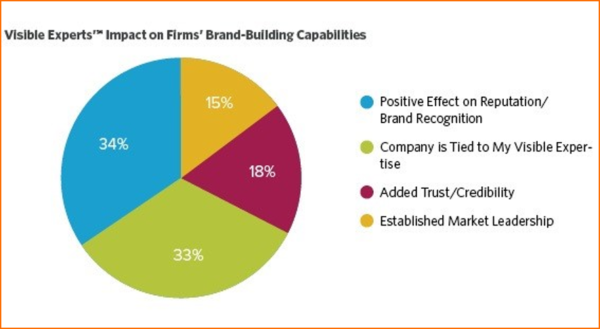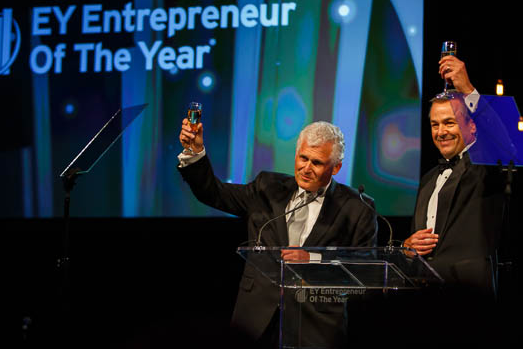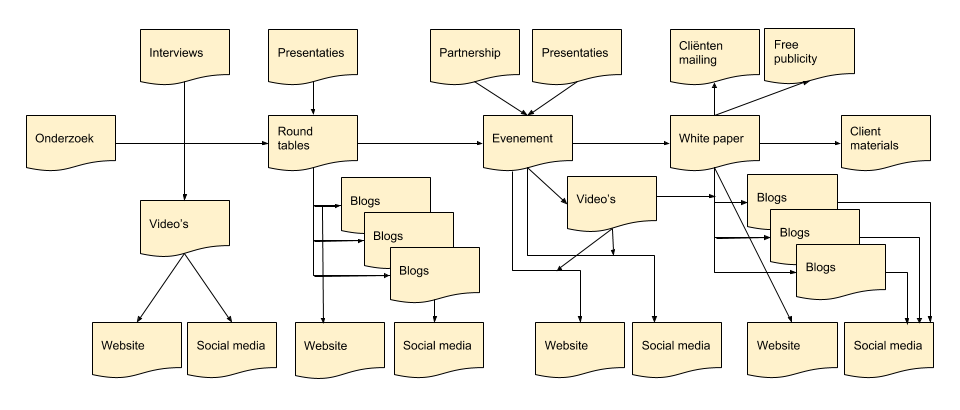How do you build a strong brand? 10 tips for accountants, consultants and lawyers

The brand is perhaps the most important asset of a business service provider. It largely determines:
- which people you can attract;
- which customers want to do business with you;
- for which type of assignments you are eligible;
- and thus how much growth and profitability you can achieve.
Nevertheless, the brand is often poorly managed at accountancy firms, consultancy firms and law firms. For example, because the brand is confused with the brand name, logo or corporate identity, so that the importance is not recognized.
Relationship management is the third pillar of the commercial result of accountants, advisers and lawyers. Click here for more on these pillars.
What is a trademark?
There are countless definitions. As far as I'm concerned, there are 3 things that determine a brand's value in business services:
- Reputation: what do people say about your brand if you are not there?
- Familiarity: how well-known and visible is your brand with the target group?
- Relevance: to what extent does what you stand for meet the needs of your target group?
BRAND = REPUTATION * KNOWLEDGE * RELEVANCE
How do you build a strong brand?
That is of course the key question. But first another question has to be answered:
What does my brand stand for?
Clarity about what you want to mean for whom and how it differs from what others offer is an essential precondition for successful brand development. More about this in my blog '8 questions for a strong proposition'.
OK. You now know what the brand stands for, what the propositions are, for whom and why. And you have translated this into clear messages. Even better. What now?
Then we are talking about brand development, branding and content marketing. Books have been written about this and I have been working on this for many years as Global Brand Development Director of EY. Far too much to describe in one blog.
That is why I have investigated what is most effective in my experience for business service providers who want to build a strong brand. I have translated this into 10 tips.
10 tips for a strong brand
- Choose topics and messages
- Improve the website
- Blog and publish
- Choose and develop figureheads
- Make smart use of social media
- Organize events and meetings
- Seek collaboration
- Professionalize the use of e-mail
- Create coherence and involvement
- Monitor and evaluate
I will now discuss these tips.
Choose topics and messages
Before you can start meaningfully with branding or content marketing actions, you have to translate the brand proposition into topics or themes that your target group finds important. The idea behind content marketing is that target groups become interested in your proposition because of what you say or show in relation to the topics on their agenda. If you do that right, they may also be interested in the proposition itself later on.
For example, if you have a proposition for large, national construction companies, you first determine which subjects are high on the agenda of these companies. For example, by checking their website, annual report, social media posts, etc. and by talking to people who know this target group well or who belong to it. Then you determine for which of these topics your proposition is interesting and what your vision is on these topics. By translating this vision into a few key messages, you create consistency in your story, laying the foundation for recognition among the target group.
Brand level versus specialties and markets
In addition to the 'corporate proposition' at the brand level, most service providers usually have a number of propositions that are related to specific specialties (eg VAT, environmental law, change management) and / or markets (eg wealthy individuals, industrial companies in North Brabant).
That is fine if two preconditions are met:
- The topics and messages all logically fit in with the brand and the proposition and messages at the organizational level;
- The number of topics per proposition is limited (otherwise there is a proliferation of topics and messages, which has the opposite effect).
Halo effect
For those who find it difficult to narrow down on topics; forget it 'halo effect'not: in practice, people (and therefore decision-makers about business services) base their judgment on all kinds of things on the few things they do have an idea of. So if you show good things around some important topics, chances are you are supposed to be good in other areas too. This is certainly how it works in business services.
"In a study asking for the best consultancy by type of advice, McKinsey finished in the top 3 for an area of advice in which they are not active at all!
2 Improve the website
If it is clear what the topics, messages and propositions are on which you want to be recognized as an accountant, consultancy or law firm, then translate this to the website!
Research shows that the vast majority of your potential customers take a look at the website before determining whether they want to speak to someone from the organization. If the prospect does not have a good feeling about what he or she finds on the website, it has already dropped out before you have had any personal contact at all!
There are quite a few business service providers with a website more like a digital business card. There are tons of books, articles and blogs written about websites, in this blog there is no space to go into all aspects that are important. What I want to say is that in my opinion the most important thing is that the website is aimed at the target group (s). So not only 'about us', 'our people', 'our approach', etc., but above all: what questions or needs do you have what vision or solutions? Let customers have their say, use images, preferably video.

A second point is that the website must match the image that people get of you through other channels. A website is regularly developed as if it were a standalone 'project'. However, if a visitor to a flashy, hip website makes an appointment and then finds an extremely solid, formal professional, then something is not going well! This also applies to other channels, such as publications, meetings, office buildings, presentations: consistency is key.
I recently spoke to the owner of an accounting firm. He said that they want to professionalize their marketing approach, but are now busy with the development of a new website. As far as I'm concerned, the marketing approach and then the website would have been a better idea.
3 Blog and publish
Blogs and publications are excellent ways to build a reputation as a brand around certain themes. In jargon we often talk about 'thought leadership'. By this I mean activities that aim to ensure that an organization is seen as an authority in a specific area (subject or market) by bringing knowledge and insights about that area to the attention of target groups. Consider, for example, the publication of research reports, blogs or white papers.
Reports and white papers
The classic way is to publish (mostly thick) reports, preferably based on research. This is a proven concept, especially for large offices. It is an excellent way to convey authority on a particular topic, although in practice such reports are often produced by outside researchers and copy writers.
A problem with such reports is that producing high-quality, research-based content is very expensive, while 'thick reports' often end up unread. That is why it is usually smarter to make slightly less thick reports and - more importantly - to provide content that can be (re) used in different ways and moments. Consider, for example, a series of interviews, which are first shared as videos via social media, on the basis of which a report is issued afterwards. Or a study, the results of which are published in a series of short partial publications ('bite-sized chunks'), instead of shooting all ammunition at once.
Or use a survey as the basis for an index or barometer that scores organizations on a topic that matches one of your propositions. For example, an accounting firm that publishes a Transparency Index with which organizations can be scored in different transparency areas. Such research can be (re) used in many ways, not only for brand development but also for generating leads.
Blogs
And then of course we have the blogs. Friend and foe agree that blogging is the most effective tool for attracting prospects to your website. Therefore, what visitors find on the website must fit seamlessly with the topics and messages of the blogs. Another important advantage of blogs is that they can be further promoted and shared via social media, so that the potential reach is large.
It is an extremely attractive tool for accountants, consultancy firms and law firms, which are essentially deployed for their knowledge and expertise. But at the same time, it is not easy to be successful with blogs. There are plenty of things you can do to make a blog more effective, but the value of your content to the audience is ultimately decisive. Professionals are often so full of their profession that they find it difficult to write about it in a way that appeals to the target group.
So blogging only when there is not enough billable work is not a good idea!
In addition, it is important that you blog regularly. It also takes serious time to write a good blog regularly. Professional editors can certainly help with this, but the ideas and vision must come from the person who has the expertise and customer contact. My advice is to place the responsibility for writing blogs on people who have a feeling for it and who like to do it. Otherwise it is doomed to bleed to death.
Choose and develop figureheads
The discussion about 'the guy' or 'the tent' is timeless. With successful business service providers it is 'and-and': just as the professional can more easily achieve results if he or she represents a strong brand, so a brand is an empty shell if it is not represented by real people with names and faces. In the legal profession in particular, the person is often more decisive than the brand. Even then, however, the effect of some strong figureheads on the brand is undeniable, benefiting all other professionals.
It is therefore important to link the topics that you want to be known for as an organization to people who can represent the brand in this area. Where the chairman of the board is first to represent the organization on corporate or social issues, sector specialists and SMEs (subject matter experts) can be appointed for specific markets or areas of expertise.
Working with figureheads offers both external and internal advantages. Externally, figureheads give the brand a recognizable face in a certain market or around a specific theme. After all, it would be confusing if you first read a story about retail from the same professional, then find a video in which he talks about ICT and see a few days later that he gives a lecture about housing corporations.
It is much more effective to build a number of 'sub-brands', each with a figurehead with its own personal brand. And it works here too halo effect: the reputation of the figureheads strengthens the image of the brand and creates more positive expectations towards fellow professionals of this figurehead. Consider, for example, the effect of Wouter Bos representing KPMG, or Jan Peter Balkenende at EY. In fact, the brand consists of the combination of the corporate brand of the office and the sum of personal brands of the individual partners and employees.

Internally, working with figureheads provides focus: everyone knows who is who. Note: designating someone as a figurehead does not make him or her a figurehead! You have to build that position by consistently developing your personal brand.
Determining who should develop into a figurehead around a subject is extremely important: people must be able and willing to do it. The tendency is often great to assume that who should be the figurehead follows from the internal organization. For example, the industry president is obviously the figurehead for this market and the leader of the tax partnership must therefore become the figurehead for tax issues. Although it certainly has advantages if this internal and external role go together, someone who can manage well internally or who is the most expert in a certain field is certainly not always suitable as a figurehead.
Personal branding
In order to be successful as a figurehead, someone must be able to link his or her expertise to topics that are important to the target group, in a way that appeals to the target group. Matters such as communication and presentation skills are just as important as substantive expertise. After all, you become a figurehead by blogging and publishing, by being active on social media, giving presentations and lectures, acting as a panel member, if possible also writing a book, and so on. Of course there is a lot to train, but a certain talent in these areas is indispensable.
from Hinge's research it appears that 85% of the professionals who have quickly developed into 'visible experts' have written a book. They indicate that a book directly contributes to credibility and leads to invitations to speak, as well as for partnerships and media interviews.
In addition to skills, building a role as a figurehead also takes time and energy. That is why someone should especially like to act as a figurehead. Without an inner passion for coming out, a role as a figurehead is doomed to fail.
All reasons to be selective in the number of (prospective) figureheads. This prevents external proliferation and confusion, while internally allows others to focus their time and energy on areas for which they are more cradled.

Make smart use of social media
Nowadays, building a strong brand in business services is almost impossible without the use of social media. Sure, there are offices that still lean on a historically built reputation, but at least brands ignoring social media are missing out on opportunities.
What strikes me is that when I meet people who question the business importance of social media, they often point out the importance of personal relationships and networks. Let social media be very suitable to strengthen the development and maintenance of personal relationships! And that's just one of the ways social media is interesting from a business perspective.
Social media applications for business service providers include:
- Share insights by means of blogs / posts and updates, with which the (personal and corporate) brand is better known, remains top-of-mind and can gain authority;
- Continuously keep abreast of developments and activities of target organizations and people by following them, enabling a much more focused approach;
- Maintain and expand the relationship network in a targeted manner, for example by responding to questions or by connecting people;
- Targeted search for information about target organizations and who fulfill relevant functions, and then follow these people and approach them (directly or through a shared contact);
- Insights or propositions with, for example, sponsored updates aimed specifically at the attention of target groups, which are selected on the basis of, for example, sector, function and geography.
There are many social media channels, of which Facebook and Whatsapp are by far the most used. And - although the business importance of Facebook has increased significantly - LinkedIn is still by far the most important platform for accountants, B2B advisers and lawyers. In a following blog I will discuss the use of LinkedIn in more detail.

People want to have the lead in when they want to have contact with an organization and with whom. Traditional advertisements and push messages are therefore less and less effective and can even cause irritation and thus be commercially harmful. Social media provides a platform that allows professionals and organizations to stay top-of-mind with their target groups in a more subtle way. If used properly, this also ensures that the professional or organization is found by people who are looking for information about a certain subject.
Organize events and meetings
As important as social media is, nothing beats meeting your customers and relationships in person. Where social media is ideal for making and maintaining contacts, meetings are ideally suited to deepen and develop these relationships commercially.
In principle, all types of meetings, if properly completed, are suitable for relationship development. Think for example of round table meetings, workshops, seminars, congresses or breakfast sessions. Note: if filled in correctly, because that often goes wrong. For example, I have attended many meetings where the employees of the organizing office are just talking to each other. Also the follow-up (what happens after the event?) Is often hardly thought about.
To strengthen the brand, it is important that the event contributes to the desired image of the brand. This has to do with things like the location, the type of chairman and speakers, the number of visitors and of course the subject. For example, the EY brand derives value from a grand and spectacular event such as the Entrepreneur of the Year gala. Small-scale meetings can also have a lot of brand value if authoritative people participate. Just as personal brands of their own partners and employees strengthen the corporate brand, the personal brands of participants determine the stature of an event, and thus the effect on brand value.

Webinars
In addition to physical meetings, it is important to consider the use of webinars. Target groups are often very busy and it takes a lot of time to come to meetings. Moreover, nowadays a lot of information can also be found on the internet. All reasons why it is often difficult to get a good turnout at meetings. That is why - especially if the target group is spread geographically - it is interesting to also use webinars.

Click here for a planning checklist of the Content Marketing Institute for a successful webinar.
Seek collaboration
Association with organizations that have a good reputation with the target group is another effective way to strengthen their own brand. For example, the cooperation of EY in the Dutch Entrepreneur Of The Year program with VNO-NCW and the Ministry of Economic Affairs contributes to the stature of the program and to the EY brand.
This approach is also great for research: conducting research in collaboration with an authoritative university or institute will gain both research status and brand reputation.
It is also often interesting to provide (parts of) teaching programs together with an educational institution or to give guest lectures. This not only contributes to the stature of the professional; it also reinforces the reputation and reputation of the brand among people who will soon enter the labor market. This makes it an excellent way to identify potential clients and it also contributes to attracting new employees.
Sponsorship
Sponsorship is akin to cooperation. By that I do not mean placing a billboard along a hockey field or logo mention in a program booklet. A lot of budget is wasted with such stand-alone initiatives. Sponsorship is only effective if it supports the brand values and is activated with a well thought out program. A rule of thumb here is that the activation budget must at least be equal to the sponsorship fee, in other words, with the sponsor contract it actually only starts.
8 Professionalize the use of email
With the rise of social media and the declining use of email, you might think that it is no longer interesting to use email. Nothing is less true. In every study into the effectiveness of marketing tools, it appears that, when used correctly, email is in the absolute top in terms of ROI.
E-mail is an excellent way to retain customers and remain top-of-mind with the target group. Moreover, it is an important channel for generating traffic to the website and leads.
Then I am not talking about the traditional newsletter, where the recipient is free to find out whether it contains something relevant: personalization is essential, not only in the salutation but also in terms of content. This may concern relevant new insights, but e-mail is also perfect for updates and alerts about current developments. For example about how to deal with a court decision or tax change.
Obviously, the legal rules for the commercial use of e-mail must be complied with. But it is equally important that email messages are perceived as valuable by the target group. The recipient can of course unsubscribe, but then you are actually already too late. In addition, I think it is very important to sharply manage the frequency with which someone receives an e-mail message. For example, an unsolicited, weekly message can lead to irritation and therefore not only to unsubscribe but also to image damage.
Click here for a digital handbook from Hinge on the use of e-mail by business service providers.
9 Create coherence and involvement
The central message of the 8 pillars of the commercial result of business service providers is that only an integrated approach is successful: not one trick, but a coherent use of different instruments leads to success.
The same applies to the instruments with which you can strengthen the brand: by using the different instruments as part of one or a few brand programs, the greatest effect is achieved. For example, as Global Brand Development Director I led the EY program 'Growing Beyond'. Dozens of activities took place from this program, ranging from thought leadership to events, customer propositions and internal engagement activities, all based on one theme and vision.
The diagram below provides a simplified illustration of how different instruments can be used in conjunction in a fire program.

10 Monitor and evaluate
You can do a lot of things, but if you don't know what the effect is, you cannot make adjustments. That is a shame, because chances are that you would get a higher return on your marketing euros with more insight.
"In a study asking for the best consultancy by type of advice, McKinsey finished in the top 3 for an area of advice in which they are not active at all!
Traditionally it is often difficult to measure things in business services: much takes place in the personal contact between professional and client. Moreover, it is often difficult to determine to what extent, for example, a person's brand image is determined by marketing activities or by his or her personal experiences with the professionals with whom he or she works.
Fortunately, in this digital age, there are many opportunities to see what is effective. The more digital channels are used, the better the possibilities to measure effect. This can even be done in real time. For example, it is relatively easy to post multiple versions of a sponsored update on LinkedIn and make adjustments based on real-time results.
But let's not forget offline measurements either. Of course, it is not always feasible to research everything, but there are also simple ways to at least gain qualitative insight into what works. For example, by regularly discussing what everyone hears from customers and what they receive in the market, by asking visitors to a meeting a number of questions or by occasionally asking people who receive email messages a few online questions.
Last but not least: reputation management
This blog is about how to build a strong brand. That is very important, but it only makes sense if you also make sure that nothing happens that damages the reputation of your accounting firm, consultancy or law firm. After all: 'trust comes on foot and goes on horseback'. What does this mean?
- In the first place: no compromises with regard to the quality of service, both professionally and in quality as experienced by customers.
- Social responsibility is also important. How are employees or the environment treated, for example? Or with transparency? Or ethical questions?
- And if, despite all efforts, something goes wrong: how do you ensure that this is immediately signaled and that there is an adequate response?
Just a few examples of preventing reputation damage. This is outside the scope of this blog but is very important!
Special position of accountants
Accounting firms occupy a special position in this regard, given their social role in audit procedures. There is much debate about what can be expected from accountants and what this means for their commercial activities.
This concerns matters such as independence, transparency and quality management. I will elaborate on this in my blogs about the pillars 'satisfied and loyal customers' and 'cross-selling'.
Classic mistakes
So far my tips for a strong brand. Unfortunately, things don't always go well. Therefore, finally, a list of common classic mistakes:
- No distinctive character defined
- Want to be everything for everyone
- No understanding of what a brand is
- No information / research
- Making a promise that cannot be kept
- Me too approach
Curious how your organization can build a stronger brand? Then contact us for a no-obligation conversation.

